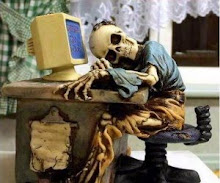Hammers
No one wanted the tools my father bought
at car boot sales and garage sales and farms:
claw hammer, tack hammer, the ornate
toffee hammer with a tiny pickaxe head.
Sometimes the handles had to be repaired -
he'd chisel where the rot was worst, blowing
out the dust, then glue in a piece of ash
and clamp it in. He'd cut a wedge of brass
to make the shaft fit tighter to the head,
then he'd work away with wire wool and turps.
Each hammer had to marinade for weeks
in linseed oil wrapped up in plastic bags.
They'd hang around the shed like dusty trophies
until he'd take one down and show us all
the glowing afterlife of wood. He'd close
his hand around them just to feel the smoothness
running through his palm, and when he died
we left them hanging in their bags. None of us
could face the task of clearing out the shed.
Maitreyabandhu
(from The Crumb Road, Bloodaxe Books)
In any man who dies there dies with him
his first snow and kiss and
fight
it goes with him.
There are left books and
bridges
and painted canvas and
machinery
Whose fate is to survive.
Yevgeny Yevtushenko
Maitreyabandhu
Yevtuskenko


